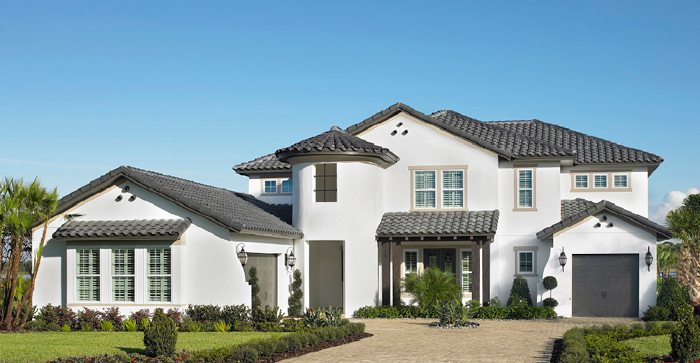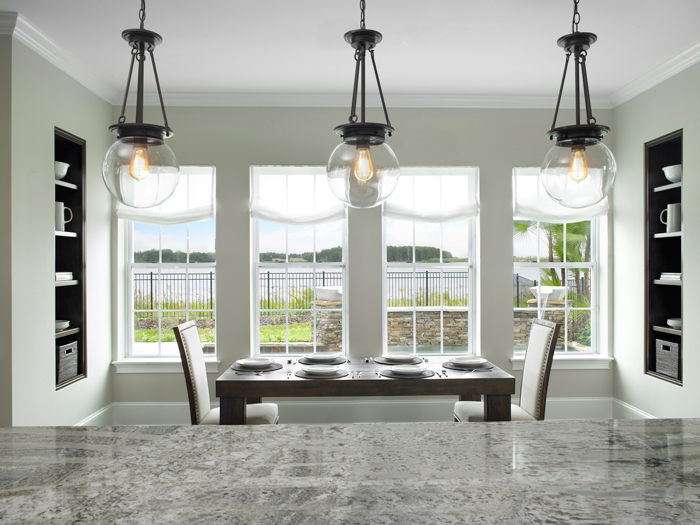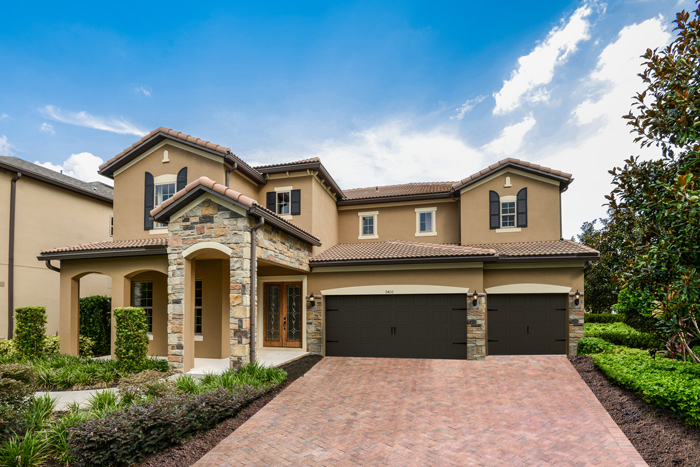WEST WORLD

Last year, Horizon West emerged as the hottest growth area in Central Florida and one of the busiest master-planned communities in the U.S. There had been fewer than 20 active neighborhoods underway in 2014. But by 2016 there were more than 50, with others debuting on an almost constant basis.
This year has been less about opening new neighborhoods — although there have been several added to the roster — than it has been about completing the neighborhoods that were started and making significant progress on all the amenities — including commercial and retail projects — that will serve all those new residents.
It’s sizzling in Horizon West these days — and smudge pots that once protected rolling aces of citrus groves during cold snaps are nowhere in sight. It’s the accumulated heat from an unprecedented flurry of construction — homes, commercial centers, roads and schools.
County officials say that about 50 percent of new-home construction permits being issued are for homes being built in the county’s southwest sector, including Horizon West. More than 25,000 people live within Horizon West’s 23 acres.
Nearly 10,000 single-family homes and five apartment complexes have been built, with more than 4,600 homesites under development. In Florida, only The Villages, the massive retirement community located mostly in Sumter County, is growing faster than Horizon West.
Although Horizon West’s individual components will be intimate and walkable, the overall scope is eye-popping. The area will ultimately be home to more than 60,000 people, which is three times the size of Winter Park.
A CHILLY PROLOGUE
Remarkably, the concept behind this history-making project was dreamed up in 1992 by a cadre of property owners — many of them growers — who regularly met for breakfast at a local diner. Over coffee and eggs, they pondered what might be done with tens of thousands of acres that hadn’t been practical for agricultural use since a ruinous Christmas Day freeze in 1989.
Why not sell it to developers, like so many other growers had done? In this case, it wasn’t quite so simple. The county’s land-use plan called for the vast tracts upon which groves had once flourished to remain rural.
Under the plan, which placed a large swath of southwest Orange County outside the urban service area, housing would be limited to one unit for every 5 or 10 acres. Property now unsuitable for citrus would be unsuitable for subdivisions, too.
Without water and sewer lines, the county’s theory went, developers would be forced to find land within the urban service area’s boundaries, thereby minimizing sprawl.
In fact, developers simply leapfrogged the rural expanses of southwest Orange and began building thousands of new homes in Lake County to the west and Osceola County to the south. Many buyers of those homes worked in Orange County.
Further vexing to the property owners — dozens of them, who cumulatively held more than 38,000 acres — was the fact that their land abutted Walt Disney World Resort to the south. With more than 52,000 jobs, Disney was, and remains, the largest single-site employer in the U.S.
Clearly, keeping southwest Orange rural didn’t make sense. Still, the property owners knew that to get the designation changed, they’d have to propose something more comprehensive, more carefully thought out and more cutting edge than anything county officials had seen before.
Not-for-profit Horizon West Inc. was formed in 1993 with the mission of putting a development plan forward. The organization hired the land-planning firm of Miller, Sellen, Connor and Walsh (now VBH MillerSellen) to craft an approach that regulators would buy into.
AN INNOVATIVE APPROACH
Company President Jim Sellen, who was Orange County’s planning director in the late 1970s, knew that county officials would never agree to extend the urban service area for piecemeal projects.
He also knew that the county had been pushing growth east, not west, because of the University of Central Florida and the Central Florida Research Park as well as Orlando International Airport.
However, Sellen agreed that saddling the decimated groves with a rural designation was counterproductive under the circumstances. The land was adjacent to major employers and it was high and dry, ideal for building. Plus, far from discouraging sprawl, the situation was making it worse.
“I encouraged the landowners to think beyond their individual parcels and present something unified,” said Sellen in an interview last year with Florida Homebuyer Orlando.
In devising a master plan for Horizon West, Sellen and his colleagues drew in part upon the pioneering work of Sir Ebenezer Howard (1850-1928), whose 1898 publication, To-Morrow: A Peaceful Path to Real Reform, described self-sufficient communities linked by road and rail. Those “garden cities” would surround a larger, central city.
But the planners also looked at current trends in New Urbanism, Disney’s Celebration development being a prime local example. In addition, they studied well-established communities such as Winter Park, which remained a model for smart planning a century after its founding.
Said Sellen in 2016: “What we came up with was so simple that it was powerful.”

IT TOOK A VILLAGE
Horizon West, as it was originally envisioned, would contain six to eight Howard-style villages consisting of two to four neighborhoods. Schools and community parks would be within walking distance — a half-mile or less — of the homes, and the size of each neighborhood would be pegged to the capacity of its school.
Each village would have its own Village Center with such essentials as a grocery store and a drug store. A major mixed-use Town Center encompassing homes, shops, offices and public areas would serve all the villages.
Bicycle and pedestrian paths would line every street and connect Village Centers and neighborhoods to one another. Thousands of acres of green space would be preserved.
Then-Commissioner Bob Freeman, whose district encompassed southwest Orange, pushed hard for the project, in part because he knew that the prospect of large-scale development would expedite extension of State Road 429. (Today the limited-access toll road, formally known as the Daniel Webster Western Beltway, runs from U.S. Highway 441 in Apopka south through Horizon West to Interstate 4 south of Disney.)
Then-Commission Chairperson Linda Chapin was also supportive, and even pressed the county to pitch in money and staff time to help finalize the presentation. Dozens of community meetings were also held to get feedback.
The next task was to convince the state Department of Community Affairs, which had the authority to approve or reject changes to local land-use plans. (The agency is now called the Division of Community Development and is part of the Department of Economic Opportunity.)
Charles Gauthier, then the DCA’s director of community planning, was initially skeptical — but changed his mind after seeing what Sellen and company had cooked up.
“Our thought was, ‘Boy, now’s the time to get out ahead of this,’” Gauthier said in a 1998 interview with the Orlando Sentinel. “In 20 years of experience, this was the most sophisticated planning I’d seen.”
To facilitate the project, the state and the county adopted an innovative, two-tiered approach that allowed Horizon West to bypass the cumbersome Development of Regional Impact review process.
The Optional Sector Planning Program, a pilot to accommodate Horizon West and four other demonstration projects throughout the state, called for the creation of a conceptual buildout plan for the entire area.
Once the larger-scale sector plans were vetted and approved, they’d be augmented by more targeted specific area plans for the individual villages and the Town Center.
Orange County approved the conceptual plan, entitled A Village Land Use Classification and Horizon West Study Report, in July 1995. In the years that followed, specific area plans have been submitted and approved as new phases have gotten underway.
A LIFESTYLE TO LOVE
The appeal of Horizon West is further enhanced by two major amenities immediately to the northeast and the southwest.
In 2010 ground was broken on Phase 1 of the Horizon West SportsPlex, which is off Tiny Road and abuts the development to the north and the northeast. The 220-acre site, operated by the county as an equestrian park, is being transformed into a multiuse center that features indoor and outdoor facilities for a variety of sports, including dozens of fields for baseball, softball, soccer and cricket.
Part of the funding for improving the SportsPlex will come from one of the largest capital investment projects in the history of Orange County, a $300 million initiative called “INVEST in Our Home for Life.”
INVEST funds will be spent on roads, pedestrian safety projects and the promotion of affordable housing throughout the county, with about $17 million to be used for parks. SportsPlex will get its share by enabling public-private partnerships that will trigger matching funds.
Abutting Horizon West to the south is the Orange County National Golf Center and Lodge, which was opened in the 1990s and has now enabled the development to offer world-class golf as an amenity without having to build a golf course.
Orange County National consists of two 18-hole courses — the Panther Lake and Crooked Cat courses — as well as a 9-hole course, a 42-acre practice facility, a 22-acre lighted putting green, an on-property lodge and a beautifully appointed clubhouse with a restaurant and meeting/event facilities.

HEALTHCARE AND EDUCATION
Southwest Orange has two premier hospitals, Health Central Hospital and Dr. Phillips Hospital, both operated by Orlando Health, as well as urgent-care centers operated by Health Central and Florida Hospital. Orlando Health also owns a parcel within the Horizon West Town Center, and plans to open an 80-bed emergency hospital and physician practice in 2018.
Adventist Health, which operates eight Florida Hospital campuses across Central Florida, opened its ninth campus in early 2016 across from Winter Garden Village, between Daniels Road and State Road 535.
The 97,000-square-foot hospital features a state-of-the-art emergency department staffed 24 hours a day, seven days a week. Other highlights include imaging equipment, lab facilities and an outpatient surgical center as well as rehabilitation and sports medicine services.
And the hospital broke ground early this year on a 72,000-square-foot medical office building next to its year-old hospital. “This building will allow us to further gather physicians of various specialties in one central location and offer even more outpatient services right here in West Orange,” said Amanda Maggard, campus CEO, in a news release.
Orlando Health, which owns about 80 acres along the south side of Porter Road, is building a two-story medical complex with a 16-bed emergency hospital on the first floor. A 103-bed hospital tower will follow next year.
In addition to an expanding healthcare scene, educational opportunities are more abundant than ever in southwest Orange. The area is home to highly rated public and private elementary and secondary schools as well as Valencia College’s bustling 180-acre West Campus. Valencia owns a parcel in the Horizon West Town Center for future expansion.
Although Horizon West is served by many public schools, perhaps none was more needed than a new high school. Windermere High School, with 2,776 students, just opened at County Road 535 and Ficquette Road.
The 350,000-square-foot high school will relieve crowding at West Orange High School, which has 4,100 students on a campus designed for just 3,000.
Independence Elementary, on New Independence Parkway, opened in August 2015, while Sunset Park and Bay Lake elementary schools opened last year in the Lakeside Village area. A middle school is slated to open in 2019, also in the Lakeside Village area.
TOWN AND COUNTRY
Southwest Orange has always been both rural and urban. It’s wealthy and middle-class. It’s defined by internationally known attractions and picture-postcard small towns. It’s forward looking and steeped in history.
And, of course, it’s dotted by shimmering lakes — more than 200 of them — along with pristine natural areas where wildlife still thrives.
Today southwest Orange is also a regional shopping and dining mecca. For example, Central Florida’s famed “Restaurant Row” stretches along Sand Lake Road near the upscale Mall at Millenia, with its world-class department stores — Macy’s, Bloomingdale’s and Neiman Marcus — and premium boutiques.
Southwest Orange is also home to much of Walt Disney World, including the Magic Kingdom, Downtown Disney and Epcot as well as Disney’s resort properties and its four championship golf courses.
Universal Orlando Resort and SeaWorld Orlando are also in southwest Orange, as are major shopping destinations such as the Winter Garden Village at Fowler Groves and West Oaks Mall.
The sector encompasses three incorporated areas: Winter Garden, Windermere and Oakland. Windermere proper is nestled on an isthmus between several lakes on the beautiful Butler Chain, which includes lakes Butler, Tibet, Down, Sheen, Louise and Chase as well as Pocket Lake, Lake Blanche, Wauseon Bay, Lake Isleworth and Little Fish Lake.
Few areas of Central Florida are more beautiful and unspoiled than the parks and preservation areas found in southwest Orange. The Tibet Butler Preserve, for example, contains more than four miles of interpretive hiking trails and elevated boardwalks radiating from the Vera Carter Environmental Center, which features wildlife exhibits and hosts a special environmental studies series for fifth graders.
The Oakland Nature Preserve encompasses 128 acres of natural shoreline on Lake Apopka, Florida’s third-largest lake. The boardwalk to Lake Apopka is the centerpiece, offering dramatic views along the lakeshore.
The preserve’s Green Trail is a loop off the boardwalk through a shady oak hammock, where you might see antelope or emus on an adjacent wildlife preserve. And its Uplands Trail is a network of short pathways through the sandhills that connect to the West Orange Trail.

EASY ACCESSIBILITY
Also key to the area’s appeal is its convenient transportation network. In addition to State Road 429, which opened in 2005, interchanges and local roads have been completed to make getting in and out of Horizon West a breeze.
The New Independence Parkway interchange (Exit 15) was created when New Independence Parkway was extended from State Road 429 east for nearly a mile to Schoolhouse Pond Road, which leads to the community of Independence.
A four-lane road, Hamlin Groves Trail, parallels State Road 429. It originates at New Independence Parkway and runs south to Summerlake Park Boulevard, which leads to the community of Summerlake.
These roads jump-started development of Hamlin, a major component of the 3,700-acre Horizon West Town Center, by creating easily accessible tracts for big-box commercial development.
Now underway is a 1.5-mile extension of Hamlin Groves Trail north and then east, where it will wrap around the Orange County SportsPlex and connect to Tiny Road near the entrance to the community of Orchard Hills. It is expected to be complete in the second half of 2018.
The extension will help accommodate traffic that new commercial development around the interchange — including a Walmart Supercenter and a Publix — will generate.
A yet-unnamed “main street” will originate on the Publix tract, in the southwest quadrant of the interchange, and run east about a half-mile to Hamlin’s waterfront lifestyle center. It should be complete by the time this issue of Florida Homebuyer Orlando is published.
About two miles to the south on State Road 429, another interchange was opened at Schofield Road (Exit 13). That interchange, which marks the southern boundary of the Horizon West Town Center, is about six miles north of Western Way, which leads to the Magic Kingdom and Disney World.
Orange County National, which attracts as many as 50,000 people during a PGA event, is on Schofield Road. And in the general vicinity, some 60,000 new homes could be built in the next decade, according to developer T. Scott Boyd.
Schofield Road also connects U.S. Highway 27 to State Road 429 roughly halfway between State Road 50 and U.S. Highway 192. That gives residents of burgeoning south Lake County a quicker route into southwest Orange County.
But the biggest transportation news impacting Horizon West is the announcement of a western extension of New Independence Parkway through a vast undeveloped tract between the Horizon West Town Center and U.S. Highway 27 in Lake County.
Boyd Development, the company behind Hamlin, is building the 5.5-mile-long road. The company doesn’t own the land flanking the road, which will take three years and at least $15 million to build.
But the road’s completion will enable other developers to potentially build at least 16,000 homes. That’s a lot of new customers for businesses in and around Hamlin — and an easy way for them to get there.
In short, Horizon West, in addition to being a self-contained community rich with its own amenities, has the added advantage of a location squarely in the center of Central Florida’s most dynamic and exciting region.
